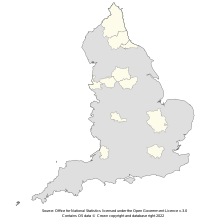Local government in England
Civil parishes are the lowest tier of local government, and primarily exist in rural and smaller urban areas.Local authorities cover the entirety of England, and are responsible for services such as education, transport, planning applications, and waste collection and disposal.[6] Their statutory functions are few, but they may provide other services with the agreement of the relevant local authorities,[7] and under the Localism Act 2011 eligible parish councils can be granted a "general power of competence" (GPC) which allows them within certain limits the freedom to do anything an individual can do provided it is not prohibited by other legislation, as opposed to being limited to the powers explicitly granted to them by law.[27] Notably, Cornwall Council has been subject to a devolution deal, which are usually reserved to combined authorities for additional functions and funding.[32] The former Leader of the Greater London Council, Ken Livingstone, served as the inaugural Mayor, until he was defeated by future Prime Minister Boris Johnson in 2008.[35] Meanwhile, it is the Assembly's role to regularly hold the Mayor and their key advisers to account and it can also amend the budget or a strategy by a two-thirds majority, though this has not ever happened as of March 2022.[7] The Secretary of State was first granted the power to create combined authorities by the Local Democracy, Economic Development and Construction Act 2009.[37] The Cities and Local Government Devolution Act 2016 gave the Secretary of State the power to provide for a directly-elected combined authority mayor.[53] In England, local authorities have three main sources of funding: UK Government grants, council tax and business rates.[61] In the financial year 2019/20, local authorities received 22% of their funding from grants, 52% from council tax and 27% from retained business rates.[61] In the financial year 2023/24, 51% of revenue expenditure is expected to come from UK Government grants, 31% from council tax and 15% from retained business rates.[27] Local government can also receive some money from fees and charges for the use of services, returns and interest from investments, commercial income, fixed penalty notices and capital receipts.[62] On a yearly basis, local government bodies review and consider whether to increase or decrease the level of council tax to fund their spending plans.[62] Between financial years 2009/10 and 2021/22, council tax rates increased by 30% in real terms, in light of reduced grants from the UK Government.[65]The Committee also said that "[t]he evidence is clear both practically and democratically that the overly centralised arrangements of government in England are problematic" and that reform was also needed of funding structures.[65] As of May 2024, the various combined authorities, county, district, and sui generis councils formed an administrative hierarchy as shown in the table below.


History of local government in EnglandPolitical make-up of local councils in the United KingdomJoint Chiefs of StaffPolitics of EnglandThe CrownMonarchCharles IIIHeir ApparentWilliam, Prince of WalesRepublicanism in the United KingdomGovernanceKing-in-CouncilPrime MinisterKeir StarmerDeputy Prime MinisterAngela RaynerLegislativeKing-in-ParliamentHouse of LordsLord SpeakerThe Lord McFall of AlcluithReform of the House of LordsHouse of CommonsSpeakerSir Lindsay HoyleMPs for England ConstituenciesRegional Affairs CommitteeElections1801 co-option1910 (Jan)1910 (Dec)1974 (Feb)1974 (Oct)JudiciaryKing-on-the-BenchSupreme CourtPresidentThe Lord Reed of AllermuirHigh Court of JusticeCourtsEnglish LawRegionsEast of EnglandLondonEast MidlandsWest MidlandsNorth EastNorth WestSouth EastSouth WestYorkshire and the HumberHistorySubdivisionsHistoric CountiesCeremonial CountiesMetropolitan and non-metropolitan countiesMetropolitan countyNon-metropolitan countyGreater LondonUnitary authoritiesDistrictsMetropolitan BoroughNon-metropolitan DistrictLondon BoroughCombined authoritiesMayoral Council for EnglandCivil parishespolice and crime commissionerspolice, fire and crime commissionersnational park authoritiesin 1974unitary authorityCity of LondonIsles of ScillyGreater London Authoritystatutory bodiesdevolution dealUK GovernmentParish council (England)allotmentslitter binsbus sheltersLocalism Act 2011general power of competenceChurch of England's parishesLocal Government Act 189456 & 57 Vict.parochial church councilsLondon borough councilscountydistrict councilsmetropolitan district councilsboroughroyal boroughcouncillorsexecutive arrangementsLocal Government Act 2000overview and scrutiny committeeLondon Government Act 1963Greater London CouncilLocal Government Act 1985City of London CorporationCouncil of the Isles of ScillyMiddle TempleInner TempleLocal Government Act 1972metropolitanLocal Government Act 1992Local Government and Public Involvement in Health Act 2007educationsocial carepoliceCornwall CouncilGreater London Authority Act 1999Mayor of LondonLondon AssemblymayoralassemblyLeader of the Greater London CouncilKen LivingstoneBoris JohnsonSadiq KhanTransport for LondonCommissioner of the Metropolitan PoliceLondon Fire CommissionerLondon Plan